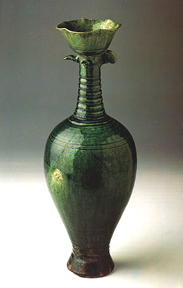
Liao dynasty, 907-1125 CE
Green-glazed ceramic
H: 37 cm.
From Liao tomb at Guojiatun
Tuquan County, Xingan League
Image courtesy of the Inner Mongolian Museum, Huhehaote (copyright reserved)
Many ceramics produced for Liao consumption reflect what may be called a classically Chinese shape, proportion and glaze pattern designs. Some, however, such as this example, demonstrate the influence of other cultures, particularly those of China's northwest and of Central Asia. While the peony and flower-and-leaf designs incised on the body are of Chinese origin, the head of the vase, shaped like a lobed cup set atop the head of a griffin- or phoenix-like creature (possibly linked to the Irano-Persian mythical creature, the simurgh), is believed by Li Wenxin and Zhu Zifang to demonstrate the influence of such peoples as the Uighurs, who were themselves influenced by patterns and designs imported from the Middle East. The vase, found in a tomb at Guojiatun in 1952, closely resembles vessels found painted on the wall of tombs in Gaochang far to the west of Liao-controlled territory, further lending credence to the theory that this vessel shape was introduced from Central China.
All information in this entry was taken from Adam T. Kessler, Empires Beyond the Great Wall: The Heritage of Genghis Khan (Los Angeles: Natural History Museum of Los Angeles County, 1993), p. 102.